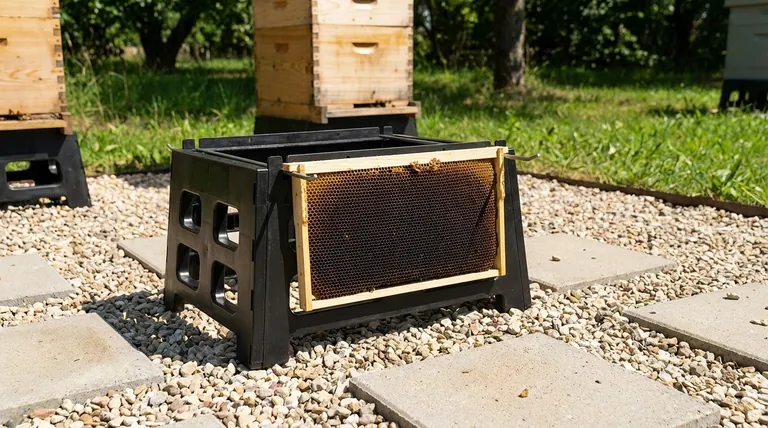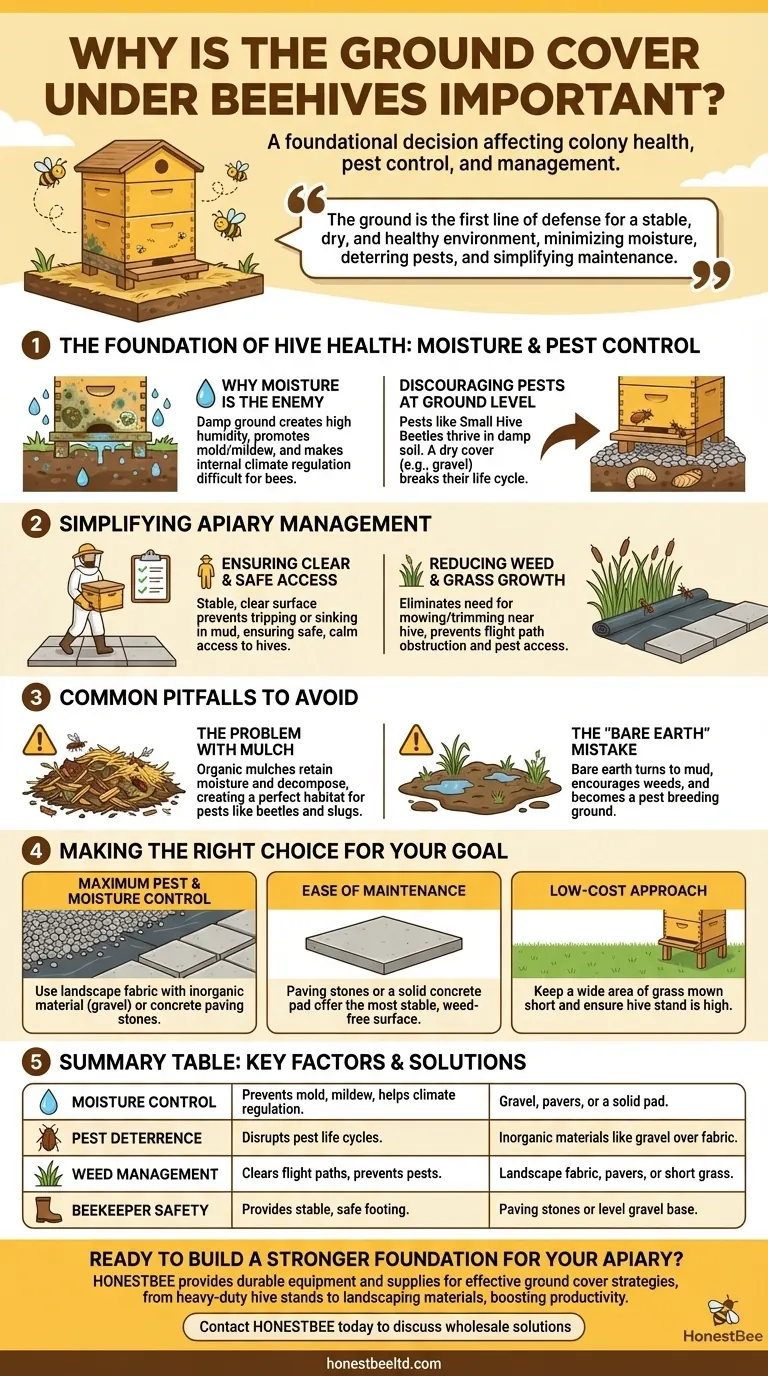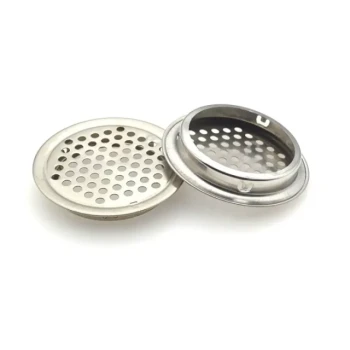Choosing the right ground cover under your beehives is a foundational decision for any beekeeper. The surface beneath a hive directly influences the colony's health and your ability to manage it effectively by affecting pest control, moisture levels, weed management, and your physical access to the hive.
The ground beneath your hive is not just soil; it is the first line of defense in creating a stable, dry, and healthy environment. A well-chosen ground cover directly supports hive health by minimizing moisture, deterring pests, and simplifying your maintenance tasks.

The Foundation of Hive Health: Moisture and Pest Control
The primary benefit of managing the ground under your hives is creating an environment that actively supports bee health and discourages common threats.
Why Moisture is the Enemy
Damp ground creates a high-humidity environment around and inside the hive. This moisture can promote mold and mildew and create ideal breeding conditions for certain pests.
Excess moisture makes it more difficult for bees to regulate the hive's internal temperature and humidity, forcing them to expend extra energy that could be used for foraging or brood-rearing.
Discouraging Pests at Ground Level
Many common hive pests, such as the Small Hive Beetle, thrive in damp, dark soil. Their life cycle often involves a stage where larvae leave the hive and pupate in the ground.
A dry, well-drained ground cover, like gravel or pavers, makes the soil inhospitable. This can break the pest's life cycle and significantly reduce the pressure on your colonies.
Simplifying Apiary Management
A well-planned ground cover isn't just for the bees; it makes the beekeeper's job significantly easier and safer.
Ensuring Clear and Safe Access
Working your hives requires carrying heavy equipment. A stable, clear surface prevents you from tripping over weeds or sinking into mud, especially after rain.
This ensures you can approach and work your hives calmly and safely, minimizing the risk of dropping equipment or jarring the colony.
Reducing Weed and Grass Growth
Tall grass and weeds growing up against the hive entrance can obstruct the bees' flight path and provide a pathway for crawling pests like ants to enter the hive.
An effective ground cover eliminates the need for mowing or using a weed trimmer directly next to the hive, which can disturb and aggravate the colony.
Common Pitfalls to Avoid
While any ground cover is often better than bare, damp earth, certain choices come with their own set of challenges. Understanding these trade-offs is key to making an informed decision.
The Problem with Mulch
Organic mulches, like wood chips or straw, can look natural and are effective at suppressing weeds. However, they retain moisture and decompose over time.
This combination of dampness and decaying organic matter can create a perfect habitat for pests like Small Hive Beetles, slugs, and earwigs, potentially worsening the very problem you are trying to solve.
The "Bare Earth" Mistake
Simply clearing a patch of dirt may seem like the easiest option, but it often leads to problems. Bare earth quickly turns to mud, encourages weed growth, and can become a breeding ground for pests.
Without a barrier, you are constantly fighting a battle against nature reclaiming the space, which requires more work in the long run.
Making the Right Choice for Your Goal
Your choice of ground cover should align with your local climate, budget, and beekeeping goals.
- If your primary focus is maximum pest and moisture control: Use a base of landscape fabric covered with a thick layer of inorganic material like gravel, or place your hives on concrete paving stones.
- If your primary focus is ease of maintenance: Paving stones or a solid concrete pad provide the most stable, weed-free working surface that requires minimal upkeep.
- If your primary focus is a low-cost approach: At a minimum, keep a wide area of grass around the hive mown very short and ensure the hive stand is high enough to prevent damp soil contact.
By managing the ground beneath your hives, you are actively shaping a healthier and more productive environment for your colonies.
Summary Table:
| Key Factor | Impact on Hive Health | Recommended Solution |
|---|---|---|
| Moisture Control | Prevents mold, mildew, and helps bees regulate hive climate. | Gravel, pavers, or a solid pad. |
| Pest Deterrence | Disrupts life cycles of Small Hive Beetles and other pests. | Inorganic materials like gravel over landscape fabric. |
| Weed Management | Clears bee flight paths and prevents pest access. | Landscape fabric, pavers, or closely mown grass. |
| Beekeeper Safety | Provides stable, safe footing for hive inspections. | Paving stones or a level gravel base. |
Ready to build a stronger foundation for your apiary?
As a leading wholesale supplier to commercial apiaries and distributors, HONESTBEE provides the durable equipment and supplies you need to implement effective ground cover strategies. From heavy-duty hive stands to landscaping materials, we help you create a stable, healthy environment for your colonies, boosting productivity and simplifying management.
Contact HONESTBEE today to discuss your commercial beekeeping needs and discover how our wholesale solutions can support your operation's success.
Visual Guide

Related Products
- Plastic Bee Hive Stand for Beekeeping
- Metal Hive Feet Bee Hive Stand for Ant Protection
- Langstroth Screen Bottom Board for Beekeeping Wholesale
- Metal Bee Hive Stand Bee Box Stand for Beekeeping
- Professional Insulated Winter Hive Wrap for Beekeeping
People Also Ask
- Why is it important to level a hive stand properly? Prevent Catastrophic Failure & Ensure Hive Health
- How do bees regulate ventilation and temperature in the hive? Master Hive Climate Control
- How does the longevity of plastic bee hives compare to wooden hives? Discover the Durable Choice
- How do bees regulate the temperature of their hive during the summer? Discover Their Natural Cooling System
- What is the purpose of a hive stand in a Langstroth hive? Protect Your Hive and Boost Colony Health



















